- News
- Reviews
- Bikes
- Accessories
- Accessories - misc
- Computer mounts
- Bags
- Bar ends
- Bike bags & cases
- Bottle cages
- Bottles
- Cameras
- Car racks
- Child seats
- Computers
- Glasses
- GPS units
- Helmets
- Lights - front
- Lights - rear
- Lights - sets
- Locks
- Mirrors
- Mudguards
- Racks
- Pumps & CO2 inflators
- Puncture kits
- Reflectives
- Smart watches
- Stands and racks
- Trailers
- Clothing
- Components
- Bar tape & grips
- Bottom brackets
- Brake & gear cables
- Brake & STI levers
- Brake pads & spares
- Brakes
- Cassettes & freewheels
- Chains
- Chainsets & chainrings
- Derailleurs - front
- Derailleurs - rear
- Forks
- Gear levers & shifters
- Groupsets
- Handlebars & extensions
- Headsets
- Hubs
- Inner tubes
- Pedals
- Quick releases & skewers
- Saddles
- Seatposts
- Stems
- Wheels
- Tyres
- Health, fitness and nutrition
- Tools and workshop
- Miscellaneous
- Buyers Guides
- Features
- Forum
- Recommends
- Podcast
feature
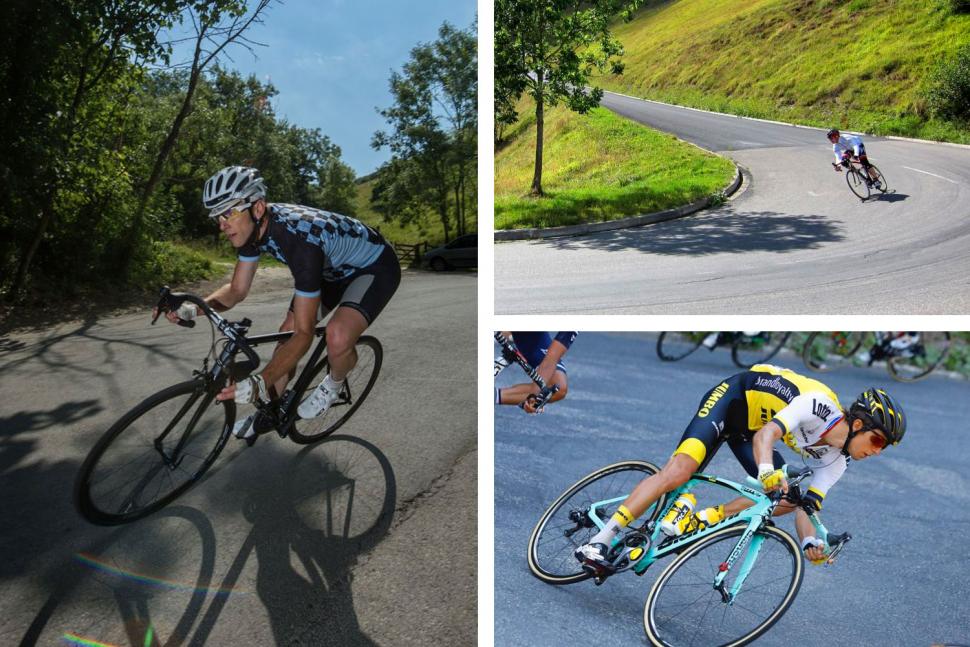 11 tips for better cornering October 2018
11 tips for better cornering October 201811 tips for better cornering — get round bends faster
Fine-tuning your cornering skills will make you faster and safer. Here are our tips for getting it right.
1. Assess the corner
On your approach to a corner you need to gauge how much speed you can carry through it. How tight is it? Can you see around it? What is the road surface like? Are there any drain covers? How wide is the road? What are the conditions? Is there traffic?
You can just pedal normally around shallow bends, but you’ll need to adjust your speed and technique for tighter corners, especially if the road surface or conditions are poor.
2. Get on the drops
Get your hands on the drops for tight corners because this is your most stable riding position, lowering your centre of gravity and adding some weight to the front of your bike. Hold the handlebar firmly but not with a white-knuckle grip.
Check out our tips for better descending here.
3. Do your braking early
You’ve probably heard that you should do all your braking before the corner and none while you’re actually cornering, and we’d agree that that is what you’d do in an ideal world. However, occasionally you need to continue braking on downhill corners (particularly hairpins) or you’ll pick up too much speed to get around.
Also, you’ll sometimes find that an unknown corner gets tighter as it goes on, or you’ll simply misjudge a corner and find that you’re travelling too fast when you’re halfway around; we all make mistakes. Any braking you do when cornering needs to be as smooth and as light as possible because it’s much easier to slide than when your bike is straight and upright.
4. Change gear
If it’s a tight corner and you’re going to have to stop pedalling, use the last few seconds of the approach to shift into the gear you’ll want when you exit.
5. Spot your exit
Look where you want to go. Keep your eyes on the point where you want to exit the corner and your body will naturally adjust your leaning, steering, and line to ensure that’s where you go. It can be difficult but if you’re nervous of not making it around the bend and ending up in the ditch, try not to focus on that ditch or that’s exactly where you might find yourself.
6. Wide, apex, wide
The classic line is to go wide before the corner, cut into the apex, and then go wide again as you exit. This lengthens the corner so you don’t have to ride at such a tight angle, allowing you to carry more speed through and out the other side. Clearly, you have to be very careful when altering your position relative to the verge and we’re not suggesting that you head onto the wrong side of the road.
Fig.1 (below) shows a rider taking a left-hand bend without straying onto the opposite side of the road (in a country like the UK where we ride on the left).
Fig.2 (below) shows a rider taking a right-hand bend without straying onto the opposite side of the road (in a country like the UK where we ride on the left).
Sometimes this wide, apex, wide line isn’t necessary. For sweeping and slower corners it’s often quicker to take the shortest line around the inside of the bend.
7. Lean over
You’ll naturally lean as you corner. The tighter the corner and the faster you take it, the more you’ll have to lean. You might be surprised at just how far you can lean in dry conditions with good tyres, but bear in mind that you’ll lose grip far, far sooner if the road is wet, oily or gravelly, and it’s sometimes difficult to identify those factors in advance.
8. Sort your crank position
If you stop pedalling for a corner, position your inside pedal in the 12 o’clock position and your outside pedal in the 6 o’clock position to give yourself the maximum clearance when you lean – grounding a pedal is bad news. Push your weight down onto the outside pedal. Accelerate only once there’s enough clearance and you’re sure that applying power won’t cause the back wheel to slide.
9. Don’t overlap wheels
Overlapping another rider’s rear wheel can spell trouble if they take a different line from you around a corner. You’re better off hanging back to avoid clashing.
Read our tips for better climbing.
10. And relax!
Being relaxed is easier said than done but your cornering will definitely improve if you can stay cool, move fluidly, and think clearly. If cornering fast fills you with fear, slow it down a bit and gradually develop your skills. You’ll relax more as you gain confidence.
11. Practice makes perfect
If you’re committed to improving your skills, find a winding section of traffic-free road and ride it several times, trying to improve your performance gradually. Perhaps make up a short circuit. Work on getting your approach speed right, improving your braking, the amount that you lean the bike and the lines that you take. Try corners of different angles as well as uphill and downhill bends.
Mat has been in cycling media since 1996, on titles including BikeRadar, Total Bike, Total Mountain Bike, What Mountain Bike and Mountain Biking UK, and he has been editor of 220 Triathlon and Cycling Plus. Mat has been road.cc technical editor for over a decade, testing bikes, fettling the latest kit, and trying out the most up-to-the-minute clothing. He has won his category in Ironman UK 70.3 and finished on the podium in both marathons he has run. Mat is a Cambridge graduate who did a post-grad in magazine journalism, and he is a winner of the Cycling Media Award for Specialist Online Writer. Now over 50, he's riding road and gravel bikes most days for fun and fitness rather than training for competitions.
Latest Comments
- Freddy56 3 hours 56 min ago
The reflective nature of the fabric structure, in in a 2 layer sealed fabric-means moisture cannot pass thru, The breathability claim is lies.......
- HoarseMann 5 hours 8 min ago
Driver injured after car flips onto its roof https://www.bbc.co.uk/news/articles/cy0g9rpp8x9o
- mark1a 5 hours 26 min ago
I don't think he wants to talk about it...
- Rendel Harris 5 hours 55 min ago
Ach, dinnae fret...
- Matt Page 6 hours 3 min ago
The Prevelo Alpha Three on the main feature image is 20".
- eburtthebike 6 hours 15 min ago
£100 bonus.
- chrisonabike 6 hours 23 min ago
To be fair if this is our usual revenant they've got form in rewriting history...
- chrisonabike 6 hours 25 min ago
"At the going down of the sun, and in the morning, we will remember them ... we have to because some numpty destroyed the roll of names"....
- hawkinspeter 8 hours 29 min ago
Looks like some Barton Hill residents don't want the Liverpool Neighbourhood or at least not Marsh Lane to be a no-through-road:...


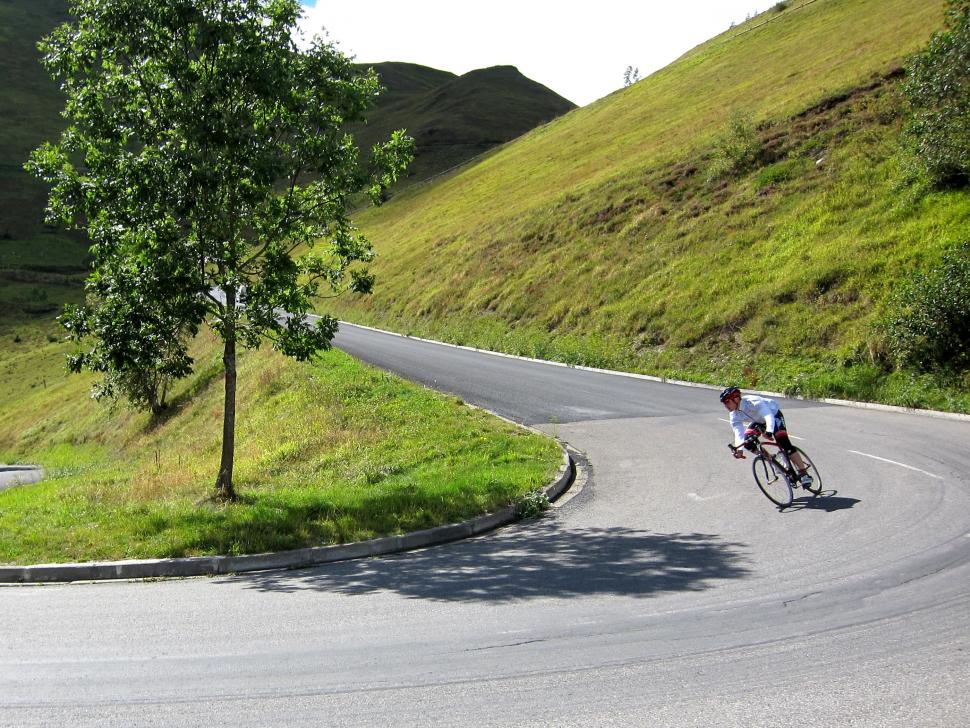
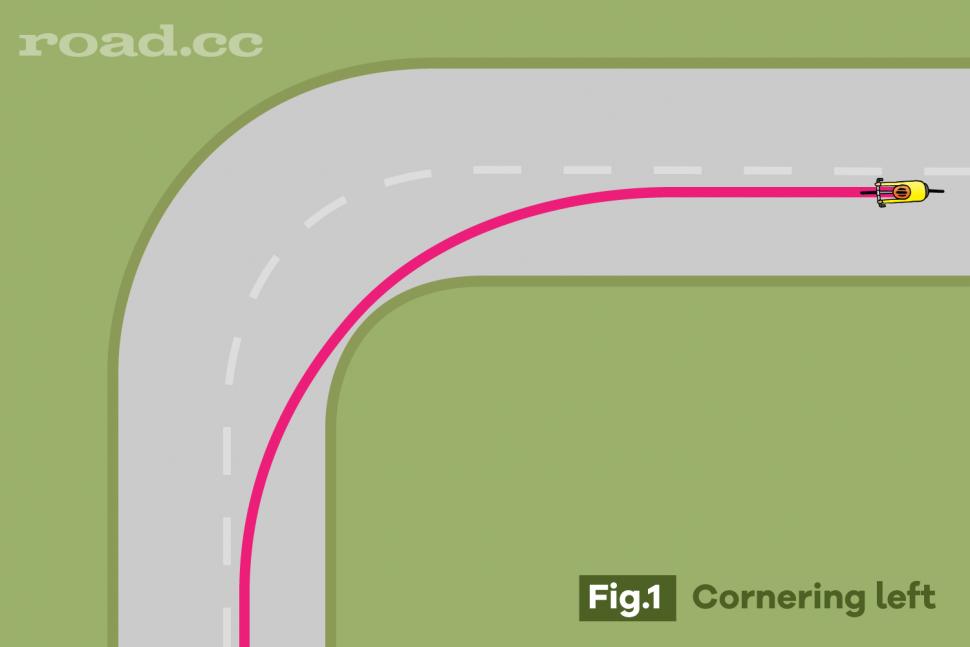
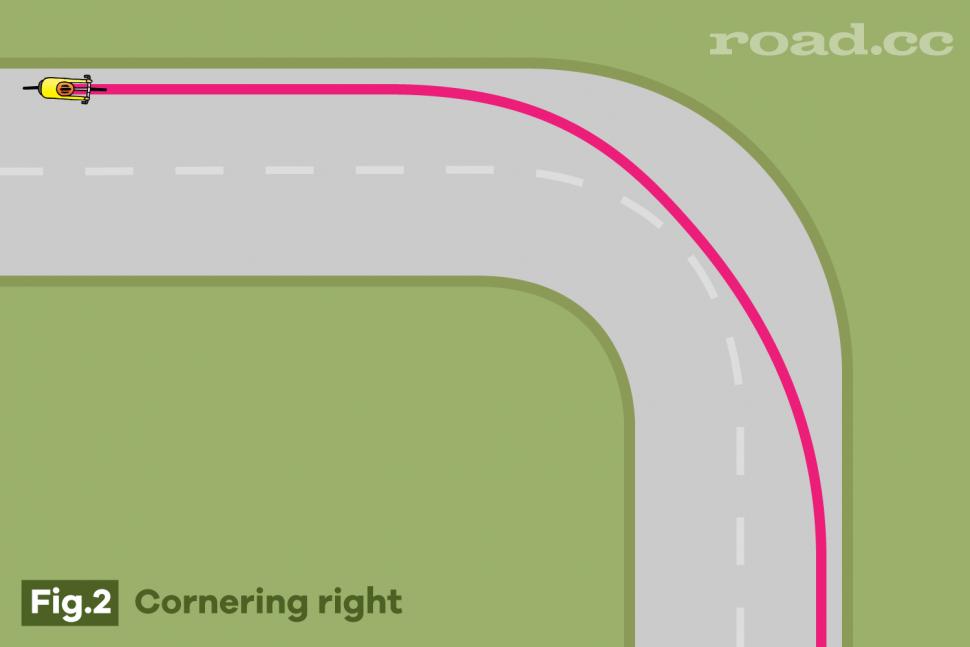
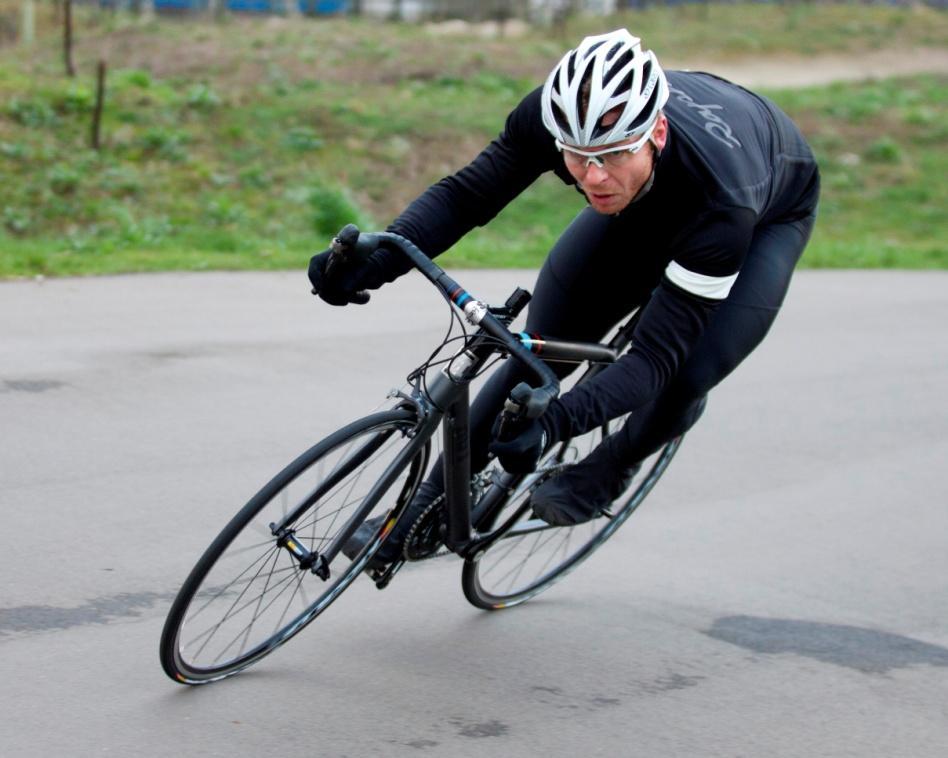

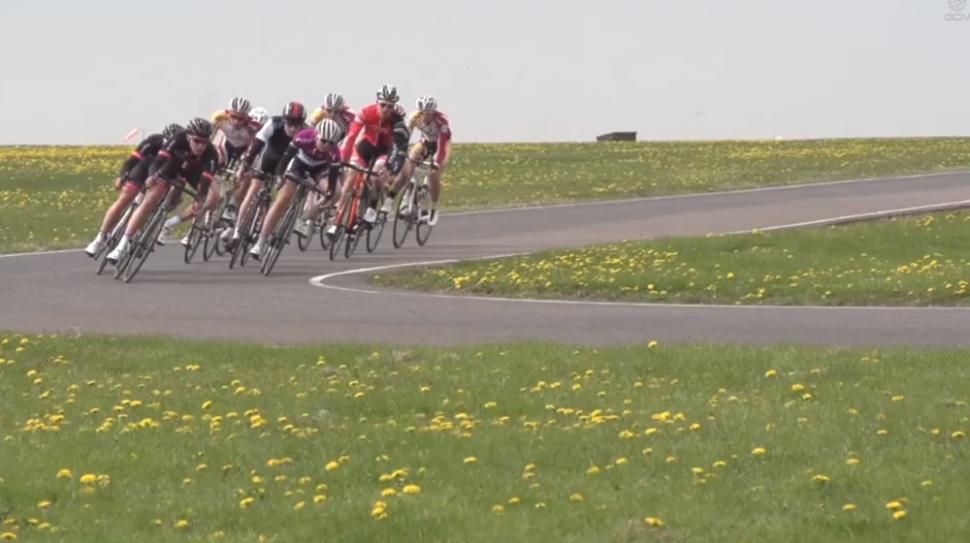
Add new comment
29 comments
Your lines are all wrong because they assume that the corner never tightens. One should always aim to apex beyond the mid-point, becasue that factors in some room for a later adjustment. It is tempting to think of the "racing line" but that is for race tracks where you can all but guarantee a good surface, no oncoming trraffic and something soft to crash into.
Your mantra of Wide, Apex, Wide gives no room for error because you have committed to use all the room available. Instead, brush off a bit more speed the Enter Wide, Apex Late, Exit Not So Wide. That will give you a better view of the exit, and will grant you room for manoeuvre during the exit.
It's all here:
Corner Schematic.pdf
You're right but only if the rider doesn't know the road. You can take a pure racing line (wide apex wide) if you know the road - say on your local Club 10- course or on your regular commut home.
Number 5 - "Look where you want to go" is the simplest but best advice you'll ever get about cornering.
Agree 100%
How do you corner when in a pack? how can you anticipate the guy in front of you being a worse cornerer that you? should you be conservative to begin with and assume he will be? or not be conservative and end up crashing into him and/or braking in the middle of the corner at the cost of traction and thus another possible crash...?!?
Also, when it gets to leaning: how do you determine how far you can go? I already hear you guys saying "practice" but when leaning and being close to lose traction, do you get a warning? or is crashing the only option?
My point is: do I have to try to lean more until the day I break a collar bone and I should then make a mental photograph or the angle I was at to know not to exceed it in the future?
It's not even that simple! What angle you can lean to will depend on your tyres, the road surface, the camber/banking of the road, temperature, whether it's wet, etc!
In my experience MTB tyres start to make more white noise as they get close to loosing grip, but road tyres don't really give any warning.
On leaning the bike:
The "push the bike down, keep the body up" style helps in situations where you might expect slides and want to be best positioned to control them when they happen. In high-speed cornering, with plenty of grip, it's slower than leaning your body with the bike. Indeed, leaning your body /more/ than the bicycle can be best, so that the tyres stay more upright than otherwise for a given angle-of-lean (measured to the CoG).
This is how it works in motorcycle dynamics too, and my experience is the same applies to bicycles.
I agree with your high-speed cornering view, as they're shallow so you don't need to tip the bike, but I don't agree with it being the same as applied to motorcycle dynamics, as the weight is much lower to the ground, whereas on a bike most of it is higher up.
Just get fatter tires. F1 cars cannot be wrong.
Fat tyres are nothing without down force (ever seen a F1 steer with no front wing?) which is just the same as weighting your outside foot, moving over your bb and countersteering
I read this article with my head tilted an extra 20° like the cameraman in the pictures.
As regards leaning into corners wouldn't keeping the bike more upright result in better grip as the tyres will not squirm as much due to grip being on the outer face of the tyre (rolling) rather than on the edge (twisting). More grip should result in more speed and less chance of wiping out.
I'm another one from the lean-the-bike-more-than-myself school, mainly because I first learned to throw a bike round a bit on a MTB, and that's stuck with me.
As has been said, it feels more like you can react quicker when you're more upright, but I'm not sure whether it's conducive to being quick round corners on the road. Look at the fella who looks like Chris Hoy in Rapha (is it Chris Hoy in Rapha?) - he looks like he means it through that bend, and he's leaning with the bike.
Put me on my aero bike against Miss Marple on her Miss Marpley bike through a chicane and it'll be close. She may well lean more.
Oh I'm sure scandinavian flicks are appreciated by all sorts of rider, but you find them in a different part of the internet.
Henri Toivonen, Lotus Talbot Sunbeam. The good old days, before electronic shite ruined motorsports.
As for cycle cornering , I find it frustrating being an ex idiot from motorbikes that liked hanging off with knee on the floor. Put some sticky tyres on , warm them up and have faith worked on a motorbike but I've never really worked out where the limit is with road cycle tyres on tarmac. Drop you shoulder and look where you want to go seems to work.
Leaning the bike and not the body is also about the cornering speed and ability to quickly switch turning directions - both of which are TYPICALLY more applicaple to MTB than Road. At low speed, it is very tough to lean your body, but you can lean the bike successfully. There are some greatn GMBN videos on youtube showing the skidding difference, they show to make a Z shape with your body so that you push you keen in but keep your body upright. Personally I subscribe to lean the bike, not the body, even on the Road, because it keeps your weight more central on the bike and therefore in more control if something unexpected happens (e.g. pothole, gravel, diesel/oil etc, surface change etc etc).
The outside pedal down point is right, but, I would add that you have to properly commit your body weight on to it to get the benefits (whilst leaning the bike inwards ), if you just hang your leg out there it won't do as much. So the post above that says to 'lift your bum off the saddle' is spot on.
), if you just hang your leg out there it won't do as much. So the post above that says to 'lift your bum off the saddle' is spot on.
Interesting the 'scandanavian flick' wasn't mentioned, but I guess on the Road it won't be much use or easy to do... More of an MTB thing I suppose!
5. Spot your exit - spot on!
Is leaning into corners right? I've always been told by coaches to lean/tip the bike into the corner, not yourself. Keeping yourself as upright as possible keeps your centre of gravity over the wheels and maintains grip, while also enabling you to keep your weight on the outside pedal.
I always lean the bike more than my body, a habit I've carried over from mountain biking, for the reasons you say.
The main benefit of doing this when mountain biking is that it rolls the tyre over so that the aggressive blocks on the edge of the tyre intended for corning are engaged with the ground. I don't think you get the same benefit on a road tyre unless it's dual compound with stickier, softer, faster wearing rubber at the edges and harder wearing, faster rolling rubber in the centre. I don't know how many road tyres feature dual compounds though.
The idea of keeping your centre of mass over the wheels seems like nonsense to me - as the mass of the bike is small relative to the rider, the angle of the bike relative to the rider will make little difference to where the rider's centre of mass is relative to the tyre contact patch, as this is determined only by the cornering force. It is possible that leaning the bike helps for other reasons, such as how the bike responds to uneveness in the surface.
Incorrect! Rubber on road does not behave like the idealised Coulomb model of friction. See conclusions section of www.mate.tue.nl/mate/pdfs/8147.pdf (Tyre/road friction modeling - Literature survey, Eindhoven University of Technology): "However the most important conclusion is that the often used Coulomb friction model with a constant coefficient of friction is in general not realistic in the case of rubber friction. " Some but not all of the reasons are mentioned above. This is one reason why F1 tyres are designed for large contact areas, although I also understand that it makes using softer, grippier rubber compounds possible without excessive wear, which would probably also apply to bicycle tyres.
I would add 'pressing down through the outside pedal to the point where it almost raises your bum out of the saddle' as another key point. This counter intuitive sounding action will offset tyre slip and allow for tighter cornering.
The bigger contact patch=more grip thing is a bit of a myth, or maybe just poor description.
Friction is a coefficient of pressure which itself is made up of force/area.
If you took the same weight and placed it on a contact patch half the size the pressure doubles and therefore the frictional resistance stays the same ish and vica versa (loads of caveats added accounting for the interaction between different materials and surfaces).
The main advantage of having a larger cantact patch is in coping with surface iregularities.
You're right. Amended.
I'm not so sure about this (I am not saying you're wrong) as in my experience fatter tyres grip better than narrow tyres and letting some air out of tyres increases grip.
To me that says bigger contact patch = more grip. I see this almost everywhere ... roadies skidding on wet roads while commuters with fatter tyres maintain grip. I can't recall ever not seeing this playing out in practice, so I would question the logic in your assertion.
Granted, you probably read an article somewhere, but real life experience tells me that larger contact patch does equate to increased grip despite pressure being lower due to being spread out over a larger area.
Something to bear in mind is that for years people believed skinny tyres were faster than slightly fatter ones, but we all know that theory has been disproved. The main reason I am using fatter tyres is because of the increased grip, which is optimal when the pressure is not set too high. Pumping your tyres up too hard decreases the contact patch and very obviously results in far less grip. This is both a fact and my experience.
Maybe there is something at play that we don't quite understand yet, but larger contact patch does = more grip, no matter how much you protest otherwise. Apologies if I misunderstood your post.
I think you need to take into account that they're probably travelling half as slowly though
I'm not so sure about this, I remeber over inflating car tyres once and the grip was far lower than normal, to the point where I stopped and let some air out.
the car obviously weighed the same, but with a much smaller contact patch grip was definately affected.
But even if correct, only onm the perfetly smooth surface of the velodrome would you be better off with skinnier tyres at higher pressure, as on typical road surfaces all the small bumps would lead to more loss of contact if the tyre was not free to deform around them.
You are both right and you are both saying the same thing. The classical law of friction only applies where the contact surface is infintely large in relation to surface irregularities. That's not what a bike, or even a car tyre has. Tyre grip is a combination of surface adhesion, roughness, deformation, and surface contamination, and at least 2 of these are improved with a bigger contact patch. A bigger contact patch also averages out surface variations, very important on a bike where we only have a square inch or so of contact at each end of the bike, and this averaging makes grip more constant, and therefore predictable.
The other point not mentioned is that when you lean the bike you are moving to a less worn part of the tyre, which depending on surface and conditions could increase or reduce grip.
Me? I aint leaning far enough to put any of the above to the test!
I have nothing useful to add, just wanted to thank all three of you for an informative discussion. I learnt a good deal from this.
If your tires is still cold due to low temperature out there, avoid doing hard cornering! you will slip and fall at 90% rate
I learn this hard way . . . my tires not warming up enough and I go hard attack cornering and then *PLANK!* "H#L% S^@IT!!"